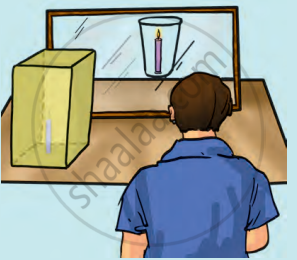Advertisements
Advertisements
Question
A burning candle in water
Take a shoe box, open on one side. Place a small lighted candle in it. Place a clear glass sheet (roughly 25 cm × 25 cm) in front of this candle figure. Try to locate the image of the candle behind the glass sheet. Place a glass of water at its position. Ask your friends to look at the image of the candle through the sheet of glass. Ensure that candle is not visible to your friends. Your friends will be surprised to see the candle burning in water. Try to explain the reason.

Solution
A Burning candle in water
Materials:
- A shoe box, open on one side
- A small lighted candle
- A clear glass sheet (approximately 25 cm × 25 cm)
Procedure:
- Place the small lighted candle inside the shoe box.
- Position the clear glass sheet vertically in front of the candle.
- Look through the glass sheet and try to locate the image of the candle behind the glass.
Observation:
- When you look through the clear glass sheet, you will see the image of the candle behind the glass.
Explanation:
- The clear glass sheet acts as a transparent medium, allowing light to pass through while slightly refracting it.
- The image of the candle appears to be located behind the glass sheet due to the refraction of light as it passes through the glass.
Conclusion:
- By using a clear glass sheet in front of a lighted candle, you can observe the formation of an image behind the glass. This demonstrates the principles of light refraction and image formation through transparent materials.
RELATED QUESTIONS
David is observing his image in a plane mirror. The distance between the mirror and his image is 4 m. If he moves 1 m towards the mirror, then the distance between David and his image will be ______.
How will you explain the statement 'we cannot see the objects in a dark room'?
Explain the following term:
Angle of incidence
Draw diagram/diagrams to show them.
An object 3 cm high produces a real image 4.5 cm high when placed at a distance of 20 cm from a concave mirror. Calculate:
- the position of image
- focal length of the concave mirror.
An object 1.5 cm high when placed in front of a concave. the mirror produces a virtual image 3 cm high. If the object is placed at a distance of 6 cm from the pole of the mirror, calculate:
- the position of the image
- the focal length of the mirror.
Give two uses of convex mirror.
What is a real image?
______ through which light cannot pass.
